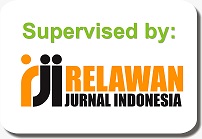ANALISIS MEDIA SIBER PADA SIARAN LANSUNG VIRTUAL YOUTUBER AYUNDA RISU
Abstract
With the creation of cyber media, nowadays almost everyone is able to do their own live broadcast. For example, today almost everyone is able to broadcast live through cyber media such as Instagram, Twitch, YouTube, Discord, and others. The fact is that today many people who work full-time and make a living are livestreamers or what can be called live broadcasters. One of the platforms that is widely used for live broadcasts is YouTube, actors who play a role in live broadcasts on YouTube are known as livestreamer youtubers. This phenomenon eventually created the term Virtual YouTuber (VTuber) or can be called a virtual YouTuber. This study aims to analyze Ayunda Risu's live broadcast. Virtual ethnography is a method used to investigate entities (users) on the internet and when these entities (users) explore when using the internet, there is a method that is able to describe this through the Cyber Media Analysis Method. Ayunda Risu's live broadcast content contains interesting and non-stale content and is monotonous to watch. So the findings from the Cyber Media Analysis on Ayunda Risu's Live Broadcast, it was found that when the Comivuro Virtual 1 and Comivuro Virtual 2 events were held, Ayunda Risu was able to replace humans as the master of ceremonies and grab the attention of the Japanese culture fandom in Indonesia.
Keywords
Full Text:
PDF (Bahasa Indonesia)References
Creeber, G., & Martin, R. (2009). Digital Cultures understanding new media. In Mc Graw Hill. Retrieved from http://books.google.com/books/about/Digital_cultures.html?id=MTnhAAAAMAAJ
Glynn, M., Taylor, J., & Every, E. (2002). The Emergent Organization: Communication as Its Site and Surface. Administrative Science Quarterly, 47, 169. doi: 10.2307/3094898
Hine, C. (2000). Virtual Ethnography.
Liudmila, B. (2020). Designing identity in VTuber era. Proceedings of Laval Virtual VRIC ConVRgence, 182–184. Retrieved from https://www.academia.edu/download/63010301/Designing_identity_in_VTuber_Era20200419-76357-12og8r3.pdf
Nasrullah, M.Si., D. R. (2016). Teori dan Riset Media Siber (CYBERMEDIA) (Endang Wahyudin (ed.); Cetakan ke). Jakarta: PRENADAMEDIA GROUP. Retrieved from https://play.google.com/books/reader?id=J-VNDwAAQBAJ&pg=GBS.PR3
Novitasari, E. (2019). akwah Melalui Media Sosial Youtube (Analisis Media Siber dalam EtnografiVirtual pada Channel Youtube Transformasi Iswahyudi). Journal of Chemical Information and Modeling, 53(9), 1689–1699.
Primasari, W. (2016). Pemaknaan Mahasiswa Ilmu Komunikasi Terhadap Media Siber. Makna (Jurnal Kajian Komunikasi, Bahasa, Dan Budaya), 1(2), 1–13. Retrieved from http://jurnal.unismabekasi.ac.id/index.php/makna/article/view/804
Puspitaningrum, D. R., & Prasetio, A. (2019). Fenomena “Virtual Youtuber” Kizuna Ai di Kalangan Penggemar Budaya Populer Jepang di Indonesia. Mediator: Jurnal Komunikasi, 12(2), 128–140. doi: 10.29313/mediator.v12i2.4758
Runte, R. (2008). New Media : the key concepts. In Handbook of the Arts in Qualitative Research: Perspectives, Methodologies, Examples, and Issues (English ed). Oxford.
Sadiq, Z. A. (2018). Using Virtual Reality to Enhances Efforts for Introduce Cultural Heritage. 11, 13–20.
Saputra, D. I. S., & Setyawan, I. (2021). Virtual YouTuber (VTuber) sebagai Konten Media Pembelajaran Online. Prosiding SISFOTEK, 5(1), 14–20. Retrieved from http://seminar.iaii.or.id/index.php/SISFOTEK/article/view/251
Silver, D., & Massanari, A. (2006). Critical cyberculture studies.
Stiawan, A., Baharuddin, H., & Amrozi, Y. (2020). Masa Depan Teknologi Komunikasi Data , Menebak Arah Perkembangannya. INTEGRER : Journal of Information Technology, 5(2), 1–5. Retrieved from https://ejournal.itats.ac.id/integer/article/view/915
Zhou, X. (2020). Virtual Youtuber Kizuna AI : Co-creating human-non-human interaction and celebrity-audience relationship. May, 1–91. Retrieved from https://lup.lub.lu.se/luur/download?func=downloadFile&recordOId=9009369&fileOId=9009370
DOI: https://doi.org/10.32528/mdk.v5i2.8391
Copyright (c) 2022 MEDIAKOM

This work is licensed under a Creative Commons Attribution-NonCommercial-ShareAlike 4.0 International License.









